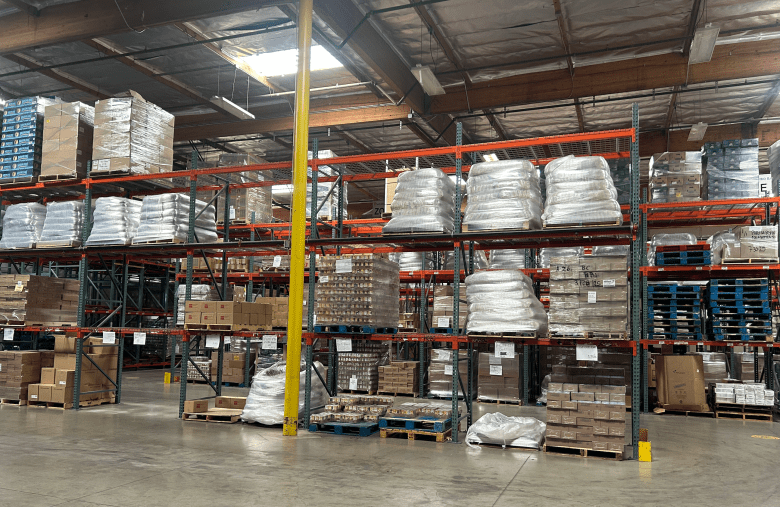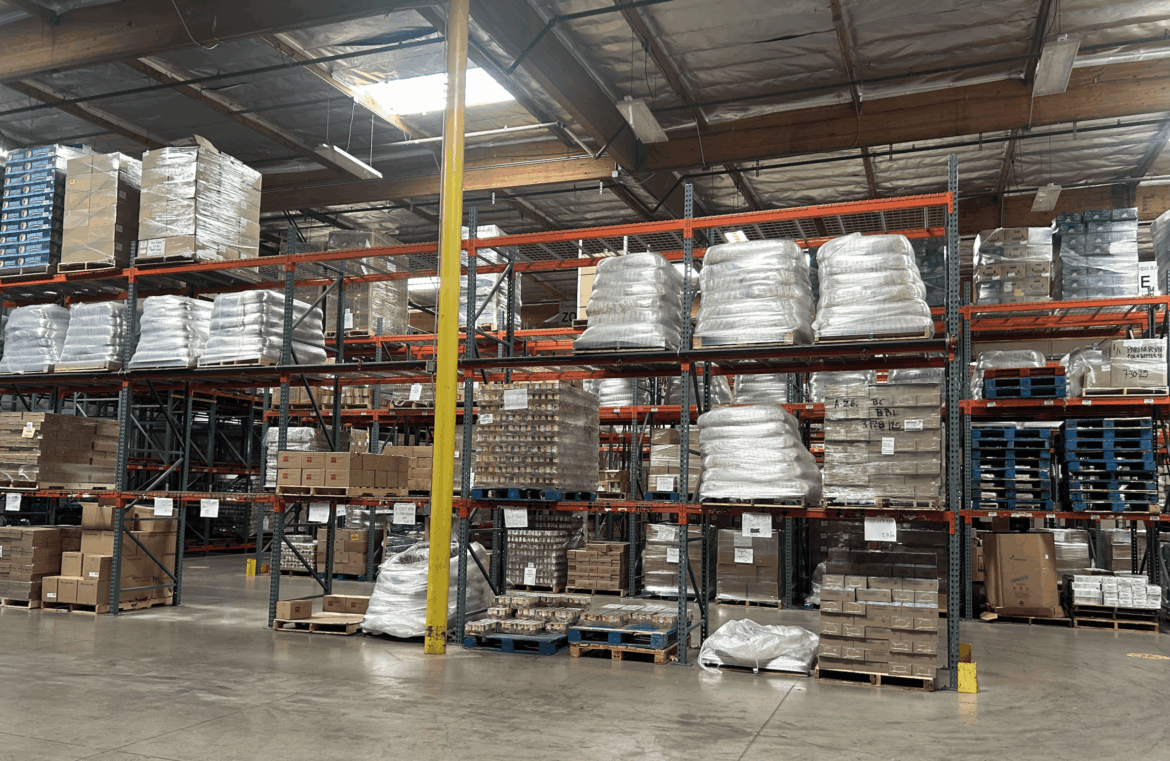 Shelves of food items at the San Diego Food Bank’s Miramar warehouse, where nonprofit partners can come and ‘shop’ for food. The SD Food Bank also has a warehouse in Vista. (Photo by James Miller/Times of San Diego)
Shelves of food items at the San Diego Food Bank’s Miramar warehouse, where nonprofit partners can come and ‘shop’ for food. The SD Food Bank also has a warehouse in Vista. (Photo by James Miller/Times of San Diego)
According to San Diego Food Bank CEO Casey Castillo, the organization will receive less food through federally-funded programs in the 2026 Fiscal Year, which began July 1.
“Nonprofits are struggling to know what resources are going to be available, and certainly that hurts the planning process,” Castillo said during an interview at the food bank’s warehouse in Miramar, which doubles as their headquarters. “But also, our food recipients are struggling with the unknowns.”
The San Diego Hunger Coalition estimated in March that around 850,000 people — about one in four county residents — are unable to provide three nutritious meals a day for themselves or their families.
The food bank estimates that because of anticipated shortfalls in food sourcing — including reduced government support — they will distribute 7 million fewer pounds of food than they had aimed to this fiscal year.
Last year, the food bank exceeded their projected distribution of 52 million pounds of food by around 900,000 pounds, feeding over 400,000 people per month.
The food bank distributes food via their fleet of 30 vehicles — loaded up with sustenance and sent to 200 distribution sites per month — and by working with 450 nonprofit partners to distribute food.
Karissa Wilburn, communications manager for the food bank, said the gap between projected and real distributions “highlights the growing challenge of meeting existing demand with fewer resources.”
Castillo said the food bank is coming up with strategies to make up the gap, which include dipping into the organization’s reserve funds to buy more food.
“We’re probably going to have to select less expensive food, and it will probably decrease the variety of items we’re able to offer,” Castillo said of the gap’s effect.
He’s optimistic the food bank will be able to make up the gap, adding that the nonprofit successfully responded to the Great Recession, fires and flooding.
During the COVID-19 pandemic, the food bank went from serving around 300,000 people every month to 600,000 people “practically overnight.”
Of the food bank’s response to the pandemic, Castillo said: “What that took was being able to put in lots of food orders — knowing that supply chains would be disrupted, but to make sure that food would come and be here on time,” adding that the strategy took a significant amount of capital, and that the organization is debt free.
The local demand for food assistance is still higher than pre-pandemic levels, and the food bank is still buying more food today than it did before the pandemic.
When federal assistance is pulled back — as it has been since March — Castillo said the SD Food Bank will purchase more food.
“We are resilient,” Castillo said. “We’ve built up reserves to take on things like this, and I think we’ve proven over time that we are able to respond when needed.”
Cuts to federally-funded USDA programs
According to Castillo, the SD Food Bank has faced cuts from federal food assistance programs funded by the Dept. of Agriculture, which had its budget cut 23% year-over-year by the Trump administration.
Commodity Credit Corporation cuts
Castillo said he was notified earlier this year that from April to July, the food bank would receive almost 2 million fewer pounds of food through Commodity Credit Corporation funds, which are part of the USDA.
He said CCC funds provide protein-rich foods, such as meats, dairy products and eggs, and the food bank is unsure if the cuts are indefinite.
CCC funds fall within the USDA’s Emergency Food Assistance Program — the food bank is the sole administrator for it in San Diego County — which provides food to income-qualifying families.
In California, a family of four making less than $75,552 a year qualifies.
Cuts to Local Food Purchase Assistance Program
Castillo said the food bank was also negatively impacted by the cancellation of the USDA’s Local Food Purchase Assistance program — a $420 million nationwide initiative that funded food banks purchasing local produce.
Castillo said that through the LFPA program, the food bank began working with a conglomerate of 50 local farms around 18 months ago.
“One of the things that that program allowed us to do is to purchase more variety, and actually because we’re working directly with these farmers,” Castillo said.
Over the course of a year, the food bank had distributed roughly 540,000 pounds of LFPA produce, primarily through their Mobile Pantry and Neighborhood Distribution Programs.
When the LFPA program was cancelled, it was allowing the food bank to buy more than $30,000 in locally grown produce each week — more than 900 produce boxes.
Wilburn said that had the program continued, the food bank anticipated sustaining — and potentially expanding — this level of local sourcing and fresh produce distribution.
Castillo said the program was creating a circular, sustainable economy between local farms and the food bank, which also gave the agency more flexibility over the produce selection.
The program also made it possible for local farmers to cultivate specific crops for interested nonprofit partners.
“We had a nonprofit partner ask us about bok choy, and so we had a farmer that was willing to grow bok choy,” Castillo said.
Increasing demand for food assistance
Lorena Galligan is the director of Third Avenue Charitable Organization, a nonprofit that provides food and social services downtown.
Her organization has seen a decrease in the amount of sought-after foods, such as poultry, available through the food bank.
As an example, she said that sometimes there are 20 cases of chicken on the food bank’s list of available items, but because there are so many nonprofit food distributors vying for those cases, its not worth it for her nonprofit — which serves more than a hundred people during free, communal meals — to take only some of the cases.
“I don’t need it because I won’t have enough food to make one meal [for everyone],” Galligan said.
In addition, roughly 65,000 San Diegans will lose access to the Supplemental Nutrition Assistance Program — colloquially known as SNAP — after the Republican budget reconciliation bill passed in early July.
Galligan said that Monday dinners and Friday breakfasts, the organization’s best-attended meals, swell to around 250 people at the end of each month because clients have run out of SNAP funds.
According to Wilburn, the San Diego Food Bank is preparing for increased demand this fiscal year for several reasons, despite some SNAP reductions not taking effect until 2028.
She said economic uncertainty and San Diego’s high cost of living have caused residents to rely more on food assistance.
“We’re already seeing a year-over-year rise in the number of people seeking food assistance,” Wilburn said via email. “This trend is expected to continue as federal investments in safety net programs decline. At the same time, the persistently high cost of groceries remains a major financial stressor for families.”


Dining and Cooking